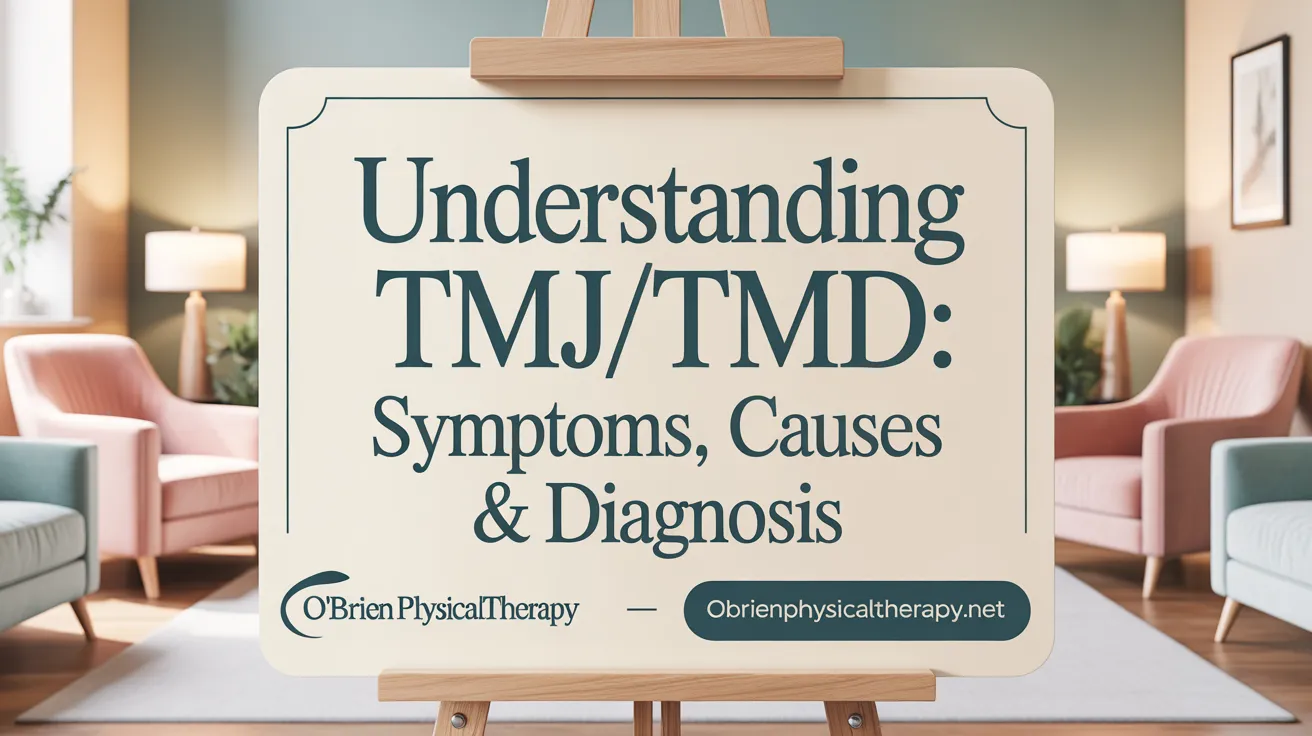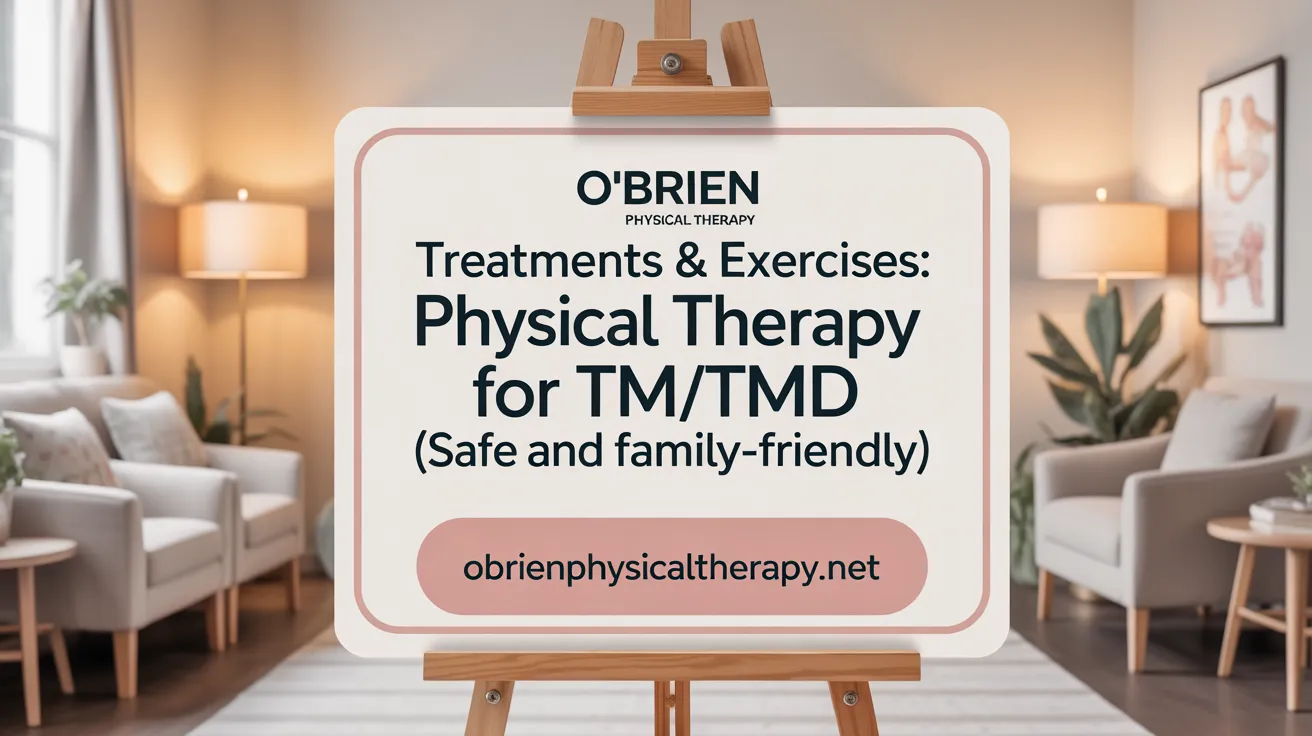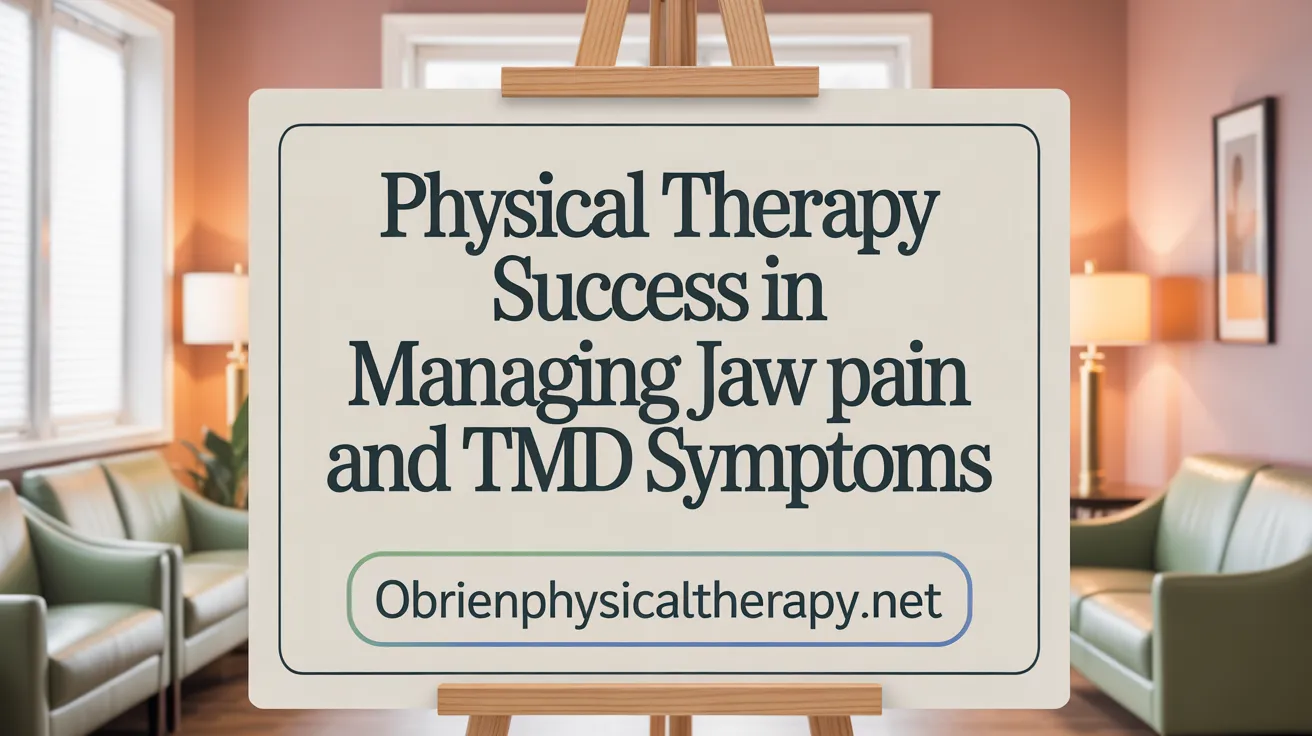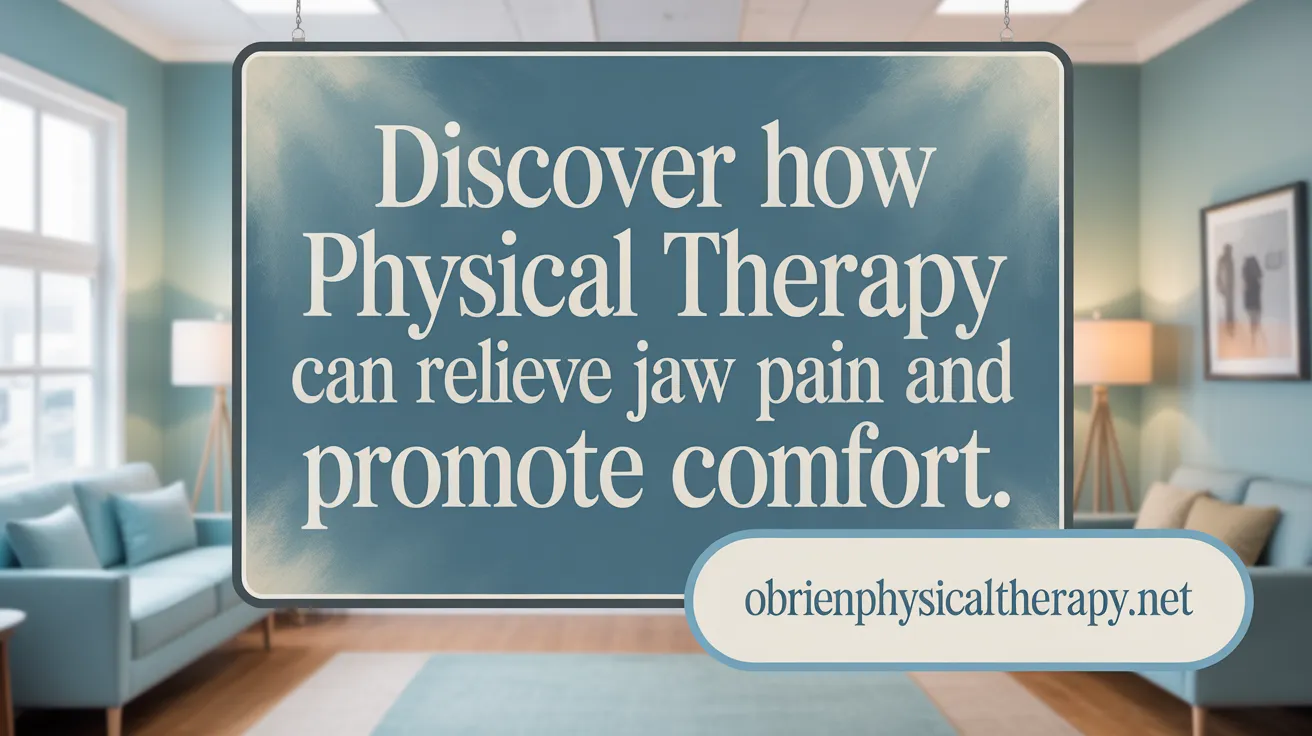Understanding TMJ Disorders and the Role of Physical Therapy
Temporomandibular joint disorders (TMD or TMJ) affect millions, causing jaw pain, dysfunction, and various debilitating symptoms. While diagnosis and treatment can be complex, physical therapy offers a promising, non-invasive approach to relieve jaw tension, enhance mobility, and restore function. This article explores the nature of TMJ disorders, how physical therapy helps, the specific treatments involved, and strategies patients can use to manage their symptoms effectively at home and beyond.
What is TMJ/TMD? Symptoms, Causes, and Diagnosis

What is TMJ/TMD, and what are its common symptoms, causes, and diagnosis methods?
TMJ (temporomandibular joint) disorders, also known as TMD, are conditions that affect the jaw joint and surrounding muscles. These issues can cause a variety of symptoms impacting daily life.
Common signs include jaw pain, headaches, earaches, clicking or popping sounds during jaw movement, difficulty opening or closing the mouth, and facial or neck discomfort. Many people also experience jaw fatigue, lockjaw, or issues with swallowing and speaking.
The causes of TMJ and TMD are multifaceted. They can stem from injury, arthritis, disc displacement within the joint, teeth grinding (bruxism), stress, muscle strain, or malocclusion—an abnormal bite or teeth alignment. Habits like teeth clenching, excessive gum chewing, or nail biting can aggravate the condition.
Diagnosis involves a comprehensive clinical examination where the healthcare provider observes jaw movement, assesses pain levels, and looks for signs of joint abnormality. Imaging techniques such as X-rays, MRI, or CT scans are often used to evaluate joint structures and soft tissues, helping to identify issues like cartilage wear, disc displacement, or joint degeneration.
Treatment options vary depending on severity. Conservative approaches include self-care, physical therapy exercises, mouth guards, medications, and stress reduction techniques. In persistent or severe cases, surgical interventions like arthrocentesis or joint surgery may be considered.
Preventive strategies focus on maintaining good posture, reducing stress, and avoiding behaviors that worsen symptoms, such as hard or chewy foods. Early recognition and management can significantly improve quality of life for individuals dealing with TMJ/TMD.
How Physical Therapy Alleviates Jaw Pain and Tension
How does physical therapy help alleviate jaw pain and tension associated with TMJ/TMD?
Physical therapy plays a vital role in managing jaw pain and tension caused by TMJ or TMD. It does so by improving the movement of the jaw joint through hands-on techniques such as joint mobilization and soft tissue massage, which help release muscle tightness and realign the joint.
Targeted exercises are a cornerstone of therapy, focusing on stretching and strengthening the muscles around the jaw, neck, shoulders, and spine. These exercises improve range of motion and help restore normal jaw function, reducing stiffness and discomfort.
Stress and tension often contribute to TMJ issues, especially when related to habits like clenching or grinding. Physical therapists teach relaxation methods, deep breathing, and mindfulness to lessen muscle tension linked to stress.
Patient education is another crucial component. Therapists advise on lifestyle modifications, such as avoiding hard or chewy foods, correcting posture, and addressing harmful habits like nail biting or gum chewing that can worsen symptoms.
By combining manual techniques, exercise therapy, stress reduction, and education, physical therapy offers a comprehensive, non-surgical approach. It aims to relax tight muscles, improve joint mobility, and promote long-term comfort, ultimately helping patients regain normal jaw function and reduce pain.
Physical Therapy Treatments and Exercises for TMJ/TMD

What types of physical therapy treatments and exercises are commonly used for TMJ/TMD?
Physical therapy offers a variety of approaches to manage TMJ disorders effectively. Therapists often employ manual therapy techniques such as joint mobilization and soft tissue massage to reduce muscle tension and improve jaw joint mobility. These hands-on methods help restore proper joint movement and relieve discomfort.
A range of targeted exercises are commonly recommended. For example, the goldfish exercises involve partial or full mouth opening, with patients gently controlling movements to increase flexibility. Relaxed jaw exercises encourage gentle opening with the tongue resting on the palate, helping to reduce tension. Chin tucks, resisted opening and closing, and side-to-side or forward jaw movements are also beneficial for strengthening muscles, enhancing coordination, and increasing range of motion.
Additional modalities like heat or cold application, ultrasound, and transcutaneous electrical nerve stimulation (TENS) are used to further ease pain and promote healing. Heat relaxes tight muscles, while cold reduces swelling and inflammation. Ultrasound therapy helps loosen tissues, and TENS disrupts nerve signaling to alleviate pain.
Beyond physical modalities and exercises, therapists focus on patient education to promote behavioral changes. This includes teaching proper posture, relaxation techniques, and habits to prevent stress and muscle hyperactivity, such as teeth grinding. Custom strategies aim to treat not just the symptoms but also underlying causes, supporting long-term jaw health.
Overall, combining manual therapy, specific exercises, thermal modalities, and lifestyle adjustments forms a comprehensive approach. This individualized plan aims to reduce pain, restore function, and prevent future TMJ issues through safe, non-invasive interventions.
Management Strategies and Techniques for TMJ Discomfort

What management strategies and techniques can patients use to alleviate TMJ-related discomfort?
Patients experiencing TMJ issues have several approaches to help reduce pain and improve jaw function. A primary method involves performing targeted physical therapy exercises. These include movements such as chin tucks, jaw side-to-side slides, and resisted opening and closing motions, which strengthen and stretch jaw muscles.
Relaxation techniques are also essential. Practices like deep breathing, meditation, and mindfulness can lower stress levels that often contribute to muscle tension and jaw clenching. Manual therapies—such as massage of the jaw, face, neck, and shoulders—help relax tense muscles, enhance circulation, and improve mobility.
Applying heat or cold therapy provides additional relief. Warm moist heat can soothe chronic muscle spasms, while ice packs help reduce inflammation and acute pain. Patients should also avoid hard or chewy foods that strain the jaw. Eating soft foods and avoiding excessive jaw movements decrease joint pressure.
Lifestyle modifications play a crucial role. Maintaining good posture, especially during work or screen time, helps reduce strain on the jaw and neck muscles. Refraining from parafunctional habits like gum chewing or nail biting can further minimize symptoms. Using a custom-fitted occlusal splint prescribed by a healthcare provider can help prevent grinding and jaw clenching at night.
Professional guidance from physical therapists or healthcare providers ensures that exercises are performed correctly and tailored to individual needs. Combining these strategies—home care, relaxation, manual therapies, and professional advice—can effectively alleviate TMJ discomfort, restore mobility, and support long-term jaw health.
The Effectiveness of Physical Therapy for TMJ/TMD Pain

How effective is physical therapy in treating jaw pain caused by TMJ or TMD?
Physical therapy has been shown to be highly effective in managing jaw pain associated with TMJ (temporomandibular joint) disorders and TMD (temporomandibular joint dysfunction). Clinical studies indicate that patients undergoing physical therapy experience significant pain reduction along with improved jaw mobility. Key techniques such as manual therapy, which involves hands-on manipulation of muscles and joints, along with targeted exercises for stretching and strengthening jaw muscles, directly address common symptoms like muscle tension, joint noise, and restricted movement.
Therapists often incorporate relaxation and posture correction strategies to reduce tension in the neck and shoulder muscles, further alleviating pressure on the jaw. Specific exercises, including controlled opening, resistance training, and jaw coordination activities, contribute to symptom improvement, often within three months of consistent treatment.
Therapeutic modalities like joint mobilization, soft tissue release, ultrasound, and TENS (transcutaneous electrical nerve stimulation) further enhance pain relief and joint function. These interventions collectively reduce muscle spasms, unlock the jaw, and diminish headaches and ear discomfort linked to TMJ issues.
While outcomes can vary depending on individual severity and adherence to therapy regimens, evidence consistently supports physical therapy as a first-line, non-invasive treatment. Its ability to provide lasting relief and improve quality of life makes it a cornerstone strategy for TMJ management.
Recognizing When to Seek Physical Therapy for TMJ Symptoms
What signs or symptoms should prompt individuals to seek physical therapy for potential TMJ/TMD?
Individuals experiencing ongoing or worsening jaw problems should consider consulting a healthcare professional, especially a physical therapist trained in TMJ disorders. Persistent jaw pain, tenderness, or discomfort that doesn’t improve with basic self-care measures are strong indicators to seek further evaluation.
Other concerning signs include difficulty opening or closing the mouth completely, locking of the jaw, or sounds such as clicking or popping during jaw movement. Headaches, facial pain, ear aches, tinnitus (ringing in the ears), and neck or shoulder pain are also commonly associated with TMJ issues.
If symptoms interfere with daily activities like eating, speaking, or yawning, or if they are accompanied by limited jaw mobility, it’s important to seek professional advice.
Early assessment and therapy can help improve jaw function and prevent symptoms from worsening. Physical therapists can develop targeted treatment plans involving exercises, manual therapy, posture advice, and stress reduction techniques.
Why is early evaluation important?
Addressing TMJ symptoms early can halt or slow down the progression of joint and muscle problems. Prompt intervention improves the chances of relieving pain, restoring normal jaw movement, and avoiding more invasive treatments like surgery.
When should I consult a healthcare professional?
Consult a healthcare provider or physical therapist if you experience persistent or severe symptoms of TMJ dysfunction, especially if accompanied by swelling, sudden worsening of pain, or difficulty moving the jaw. These signs suggest that professional assessment and personalized treatment are necessary, helping to manage symptoms effectively and support long-term jaw health.
Home Remedies and Self-Care Tips Complementing Physical Therapy
What are some home remedies and self-care tips that complement physical therapy in managing TMJ symptoms?
Managing TMJ pain often involves simple yet effective home remedies that work alongside professional treatments. Applying heat or cold packs is a common method; heat can relax stiff muscles and improve blood flow in chronic pain, while ice packs can reduce swelling and numb sharp, acute pain.
Dietary adjustments also play a role. Eating soft foods like smoothies, soups, and mashed vegetables helps decrease stress on the jaw. It’s best to avoid hard, chewy, or sticky foods, including gum or biting nails, which can aggravate symptoms.
Gentle exercises and massages of the jaw muscles can be beneficial if performed correctly. Relaxing jaw stretches, such as opening the mouth slightly and side-to-side movements, help improve mobility. Chin tucks and resisted opening and closing exercises strengthen the jaw muscles. These movements should be done gently to avoid further strain.
Maintaining good posture is essential. Keeping the head aligned over the shoulders prevents excess tension on the jaw. Avoid sleeping on the stomach or on the painful side, as these positions can increase discomfort.
Stress reduction techniques also contribute significantly. Practices like deep breathing, meditation, or guided imagery help relax tight muscles and reduce clenching or grinding habits that worsen TMJ issues.
Incorporating these home care methods can speed recovery and enhance the benefits of physical therapy, providing a holistic approach to TMJ management.
Comprehensive Physical Therapy Techniques and Their Benefits for Jaw Pain

What physical therapy methods are generally used to provide relief from jaw pain, and what are their benefits?
Physical therapy for TMJ-related jaw pain involves a variety of hands-on techniques and targeted exercises designed to reduce discomfort and improve jaw function. Manual therapy, including joint mobilization and soft tissue massage, is often used to relieve muscle tension and enhance joint mobility. These techniques can help realign the jaw joint and ease muscle tightness that contributes to pain.
Therapeutic exercises play a crucial role in physical therapy. Movements such as goldfish exercises (partial and full opening), chin tucks, resisted opening and closing, and side-to-side jaw motions help stretch and strengthen the muscles involved in jaw movement. This improves flexibility, supports joint stability, and reduces tension, leading to less pain.
In addition, modalities like ultrasound therapy, heat or cold application, and electrical stimulation methods such as transcutaneous electrical nerve stimulation (TENS) are employed. Ultrasound helps loosen muscles and improve mobility at a deeper tissue level, while heat relieves chronic muscle spasms, and ice alleviates acute inflammation.
Patient education is also integral to treatment. Therapists advise on proper posture, relaxation techniques, stress management, and avoiding habits like gum chewing or nail biting that worsen symptoms. Together, these methods aim to restore natural jaw movement, ease pain, and prevent further TMJ issues, significantly enhancing overall quality of life.
| Method | Purpose / Benefit | Additional Details |
|---|---|---|
| Manual therapy | Relieve muscle tension, improve joint mobility | Includes joint mobilization and soft tissue massage |
| Therapeutic exercises | Increase flexibility, strengthen muscles, reduce pain | Examples include goldfish exercises and chin tucks |
| Ultrasound therapy | Loosen muscles, enhance joint function | Uses ultrasonic waves to promote healing |
| Heat or cold packs | Relax muscles, decrease inflammation | Hot therapy for chronic pain, ice for acute issues |
| Electrical stimulation | Decrease muscle tension, promote relaxation | TENS for pain relief |
Understanding and applying these therapies under professional guidance can significantly aid in managing jaw pain, promoting healing, and restoring normal function.
Embracing Physical Therapy for Lasting Jaw Health
Physical therapy offers an effective, non-invasive path to alleviate jaw pain and tension caused by TMJ disorders. By combining manual therapy, targeted exercises, modalities, and lifestyle guidance, physical therapists empower patients to regain mobility, reduce discomfort, and manage symptoms proactively. Early recognition of TMJ issues, adherence to personalized therapy plans, and incorporating home care strategies further enhance outcomes. As research continues to support its benefits, physical therapy remains a cornerstone in comprehensive TMJ management, helping individuals live more comfortably and maintain healthy jaw function long-term.
References
- 9 Exercises for TMJ Pain Relief
- Physical Therapy Exercises for TMJ Disorders
- TMJ: What It Is and How Physical Therapy Can Help
- Physical Therapy Guide to Temporomandibular Disorder
- TMJ disorders - Diagnosis and treatment
- TMJ Disorders: Symptoms & Treatment
- TMJ Disorders
- The Role of Physical Therapy in Managing TMJ Disorders
- Physical Therapy for Jaw Pain: How To Stop Grinding Teeth
- 14 TMJ exercises to reduce jaw pain, stiffness, and tension
